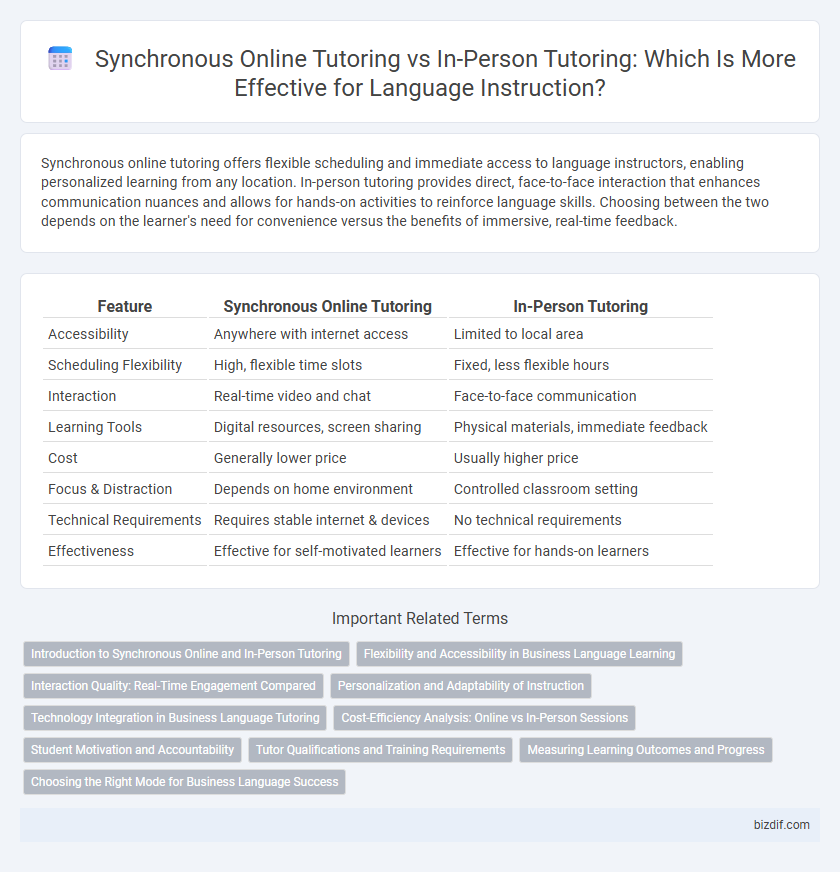Synchronous online tutoring offers flexible scheduling and immediate access to language instructors, enabling personalized learning from any location. In-person tutoring provides direct, face-to-face interaction that enhances communication nuances and allows for hands-on activities to reinforce language skills. Choosing between the two depends on the learner's need for convenience versus the benefits of immersive, real-time feedback.
Table of Comparison
| Feature | Synchronous Online Tutoring | In-Person Tutoring |
|---|---|---|
| Accessibility | Anywhere with internet access | Limited to local area |
| Scheduling Flexibility | High, flexible time slots | Fixed, less flexible hours |
| Interaction | Real-time video and chat | Face-to-face communication |
| Learning Tools | Digital resources, screen sharing | Physical materials, immediate feedback |
| Cost | Generally lower price | Usually higher price |
| Focus & Distraction | Depends on home environment | Controlled classroom setting |
| Technical Requirements | Requires stable internet & devices | No technical requirements |
| Effectiveness | Effective for self-motivated learners | Effective for hands-on learners |
Introduction to Synchronous Online and In-Person Tutoring
Synchronous online tutoring offers real-time language instruction through video conferencing platforms, enabling interactive learning regardless of geographical barriers. In-person tutoring provides direct, face-to-face engagement, allowing for immediate non-verbal communication and personalized feedback. Both methods emphasize tailored instruction, but synchronous online tutoring leverages digital tools to enhance language practice and accessibility.
Flexibility and Accessibility in Business Language Learning
Synchronous online tutoring in business language learning offers unparalleled flexibility, allowing professionals to schedule lessons around demanding work hours and from any location with internet access. In-person tutoring provides structured environments ideal for immersive, interactive language practice but often requires travel and fixed timing, limiting accessibility. Online platforms enhance accessibility by connecting learners with specialized tutors worldwide, fostering personalized learning experiences without geographical constraints.
Interaction Quality: Real-Time Engagement Compared
Synchronous online tutoring offers real-time interaction through video, chat, and screen sharing, enabling immediate feedback and dynamic communication between student and instructor. In-person tutoring provides face-to-face engagement, allowing for non-verbal cues and a more personalized, immersive learning environment. Both modes facilitate direct interaction, but physical presence in person can enhance rapport and responsiveness during language instruction.
Personalization and Adaptability of Instruction
Synchronous online tutoring leverages advanced digital tools to deliver highly personalized language instruction, adapting lesson pace and content in real-time based on students' immediate responses and learning styles. In-person tutoring offers nuanced personalization through direct observation of body language and immediate contextual feedback, facilitating adjustments tailored to students' engagement and comprehension levels. Both methods prioritize adaptability, with synchronous online platforms enabling dynamic resource integration and in-person settings fostering spontaneous interaction to optimize language acquisition outcomes.
Technology Integration in Business Language Tutoring
Synchronous online tutoring harnesses real-time communication tools and interactive software to enhance business language instruction, enabling immediate feedback and dynamic role-playing scenarios crucial for professional fluency. In-person tutoring benefits from tangible resources and face-to-face interaction, but often lacks the scalability and technological integration found in online platforms. Advanced language learning technologies such as AI-powered pronunciation analysis and virtual business simulations offer unparalleled opportunities for customized and efficient skill development in synchronous online environments.
Cost-Efficiency Analysis: Online vs In-Person Sessions
Synchronous online tutoring reduces costs significantly by eliminating travel expenses and enabling flexible scheduling, which lowers hourly rates compared to in-person sessions. In-person tutoring often incurs additional costs related to venue rental and commuting, making it less cost-efficient for long-term language instruction. Online platforms also allow tutors to reach a broader audience, optimizing their time and increasing affordability for students.
Student Motivation and Accountability
Synchronous online tutoring enhances student motivation through interactive digital tools and real-time feedback, fostering consistent engagement and accountability. In-person tutoring offers face-to-face interaction that builds personal rapport and immediate non-verbal communication, often increasing student commitment and focus. Both methods demand structured scheduling to maintain accountability, but online platforms provide flexible tracking features that monitor progress efficiently.
Tutor Qualifications and Training Requirements
Tutor qualifications for synchronous online tutoring often emphasize strong digital literacy and familiarity with virtual teaching tools alongside subject expertise, whereas in-person tutoring prioritizes interpersonal skills and physical presence. Both formats typically require certifications in education or specific language instruction, but online tutors may undergo specialized training in managing remote classroom dynamics and using interactive platforms effectively. Continuous professional development is crucial in both settings to ensure tutors remain adept at pedagogical techniques and adapt to evolving student needs.
Measuring Learning Outcomes and Progress
Synchronous online tutoring enables real-time interaction, allowing immediate feedback and adaptive lessons based on student responses, which enhances measurable learning outcomes. In-person tutoring offers direct observation of student behavior and engagement, facilitating nuanced assessments of progress through non-verbal cues and personalized adjustments. Both methods utilize formative assessments and standardized tests to track language proficiency improvements, ensuring objective measurement of student growth over time.
Choosing the Right Mode for Business Language Success
Synchronous online tutoring offers flexibility and access to expert instructors worldwide, enabling businesses to overcome geographical barriers and schedule lessons that fit their operational hours. In-person tutoring provides immersive, real-time interaction fostering quicker rapport and tailored feedback essential for nuanced language skills in professional environments. Selecting the right mode depends on company needs, budget, and desired learning outcomes to maximize business language proficiency and overall communication effectiveness.
Synchronous Online Tutoring vs In-Person Tutoring Infographic

 bizdif.com
bizdif.com